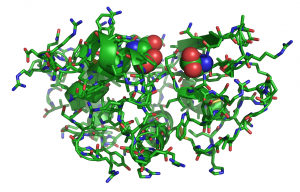SUNDAY, 4 MARCH 2012
One of the world’s smallest transistors, constructed from a single carbon nanotube, was attached to a molecule of lysozyme, a bacterium-fighting protein.
Lysozyme has been the subject of thousands of publications ever since Alexander Fleming, who was suffering from a cold at the time, first tried cultivating a sample of nasal mucus and discovered its antibacterial properties.
Proteins, which are very long, string-like molecules, need to be folded in a specific way in order to function properly. Lysozyme was the first enzyme to have its structure solved, back in 1965. However, knowing the structure alone is not enough to explain how lysozyme works - the way it moves is important too.
Lysozyme folds to form two ‘jaws’, which allow it to hold sugar chains in place in order to cut them apart by breaking a chemical bond. The development of the nano-transistor allowed scientists to study how this protein behaves in unprecedented detail. The team were able to detect lysozyme cutting through chemical bonds at a rate of 15 per second, before it got stuck and started opening and closing its jaws 300 times per second trying to find more bonds to cut (think Pac-Man!).
As the transistor is attached to a single molecule, the researchers can see how each protein behaves, rather than just looking at the average of millions of molecules. “Our circuits are molecule-sized microphones," says Philip Collins, associate professor of Physics and Astronomy, who led the project with Professor Gregory Weiss from the department of Biochemistry. "It's just like a stethoscope listening to your heart, except we're listening to a single molecule of protein."
This new research, published in Science, is the first to use carbon nanotubes for studying the activity of a single molecule. This would previously have been achieved by attaching a fluorescent dye to the protein but these often wear out within seconds. By using the nano-transistor, the team were able to ‘listen’ to the protein for ten minutes, which was crucial for them to observe the protein switching between its different forms.
This ‘microphone’ can be applied to countless other proteins, giving scientists a chance to listen to the machinery of our body at work.
Written by Ian Le Guillou
DOI: 10.1126/science.1214824

